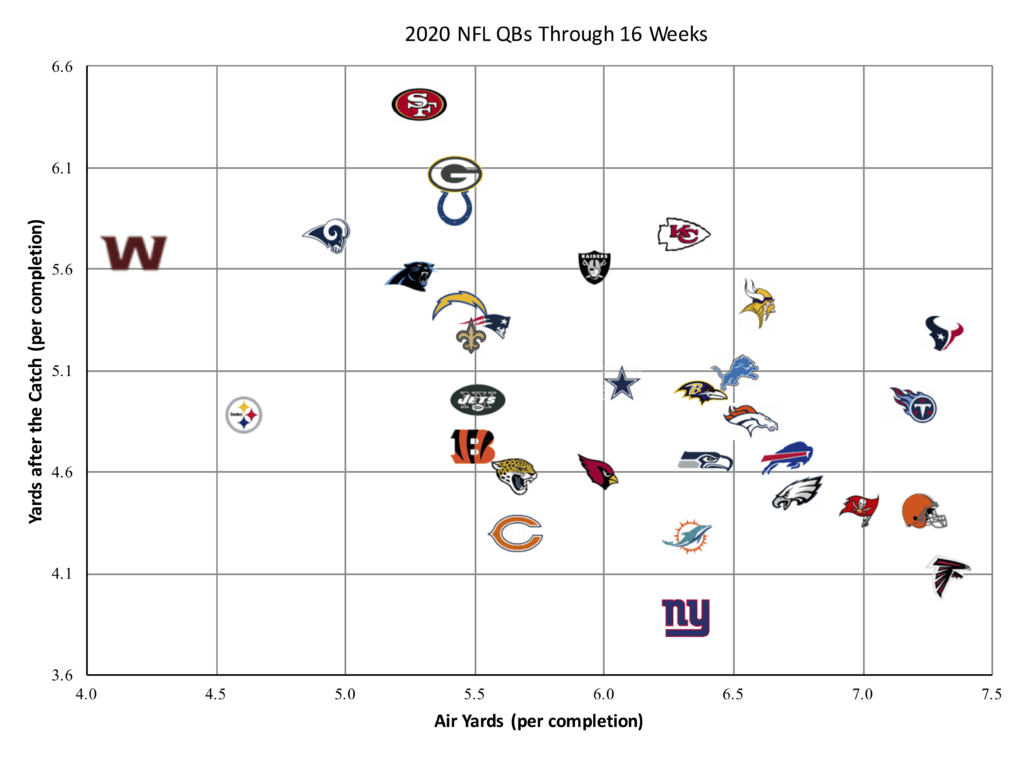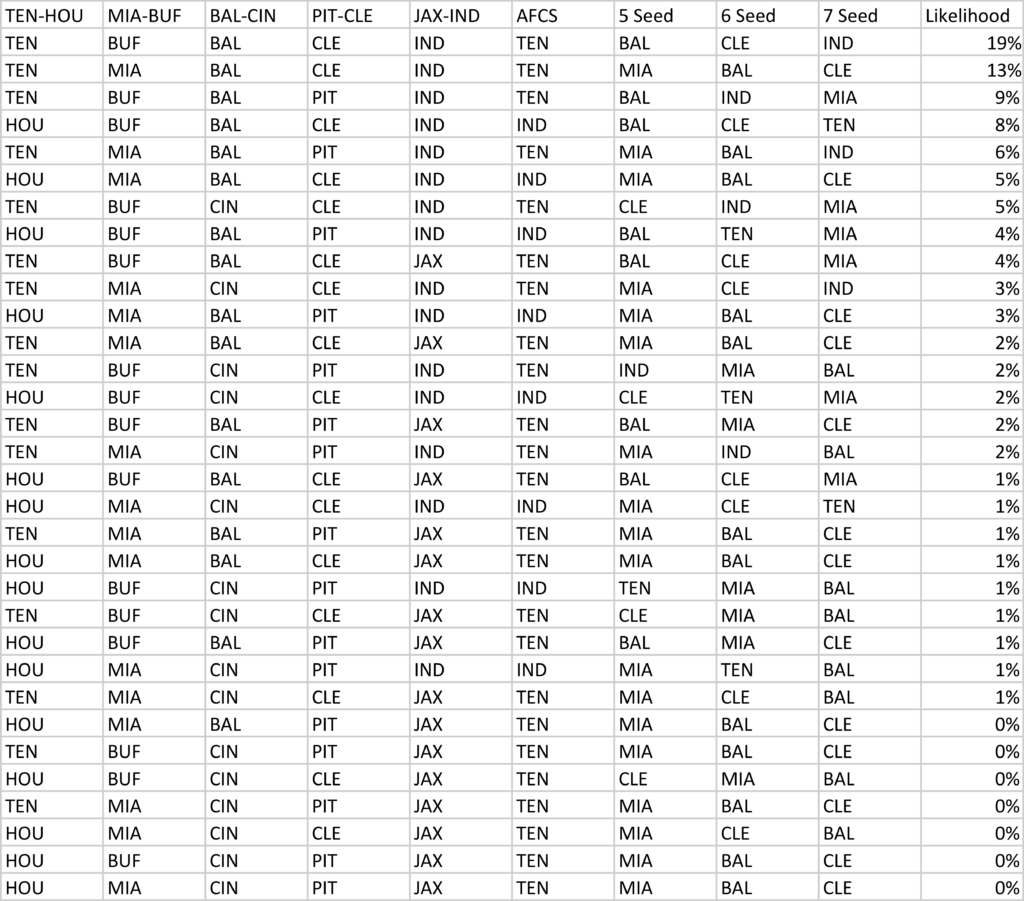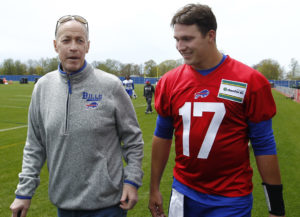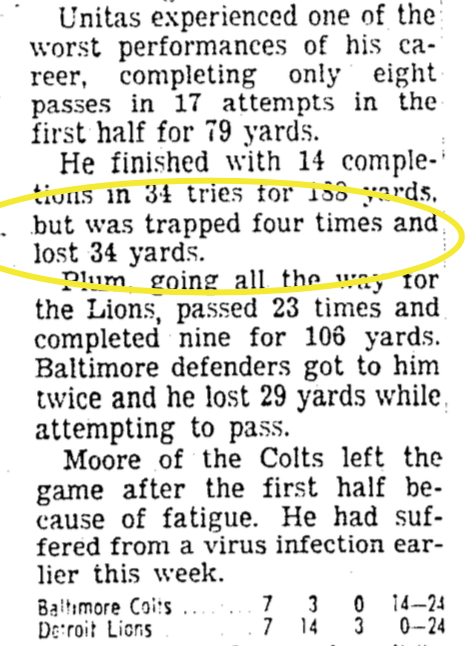Previously:
- Week 1 Passing Stats
- Week 2
- Week 3
- Week 4
- Week 5
- Week 6
- Week 7
- Week 8
- Week 9
- Week 10
- Weeks 11 and 12
- Week 13
- Week 14
- Week 15
Was this the best game of Tom Brady‘s career? Blaspehmy, you say. Given the year and the opponent, that’s probably true. Against Miami in 2007, Brady had a game where he went 21 for 25 for 354 yards with 6 touchdowns and no interceptions and one sack, putting up a perfect 158.3 passer rating and averaging 17.85 ANY/A. That went down as the 17th highest single-game ANY/A performance since 1970. New England opened that game with touchdowns on each of their first four drives, and five out of their first six.
But this may have been, statistically speaking, Brady’s second most efficient performance ever, at least without any opponent or era adjustments. Against the Lions, Brady completed 22 of 27 passes for 348 yards and 4 touchdowns, with no interceptions and just one sack. One of about 100 games since 1970 where a quarterback averaged at least 15 ANY/A on 20+ passes. The Bucs scored a touchdown on 5 of their first 6 drives, picking up a whopping 405 yards. That was all in the first half, which was more than enough: Brady did not return to the game after halftime, with the Bucs ahead 34-0.
The full week 16 passing stats below.
| Rk | Passer | Team | Opp | Result | Att | Yd | TD | INT | 1D | Sk | Yd | FL | AdjY/DB | DB | VALUE |
|---|---|---|---|---|---|---|---|---|---|---|---|---|---|---|---|
| 1 | Tom Brady | TAM | DET | W 47-7 | 27 | 348 | 4 | 0 | 17 | 1 | 7 | 0 | 19.21 | 28 | 289 |
| 2 | Brandon Allen | CIN | HOU | W 37-31 | 37 | 371 | 2 | 0 | 18 | 0 | 0 | 0 | 15.00 | 37 | 226 |
| 3 | Josh Allen | BUF | NWE | W 38-9 | 36 | 320 | 4 | 0 | 17 | 0 | 0 | 0 | 14.36 | 36 | 197 |
| 4 | Andy Dalton | DAL | PHI | W 37-17 | 30 | 377 | 3 | 1 | 13 | 2 | 15 | 0 | 14.59 | 32 | 182 |
| 5 | Ryan Fitzpatrick | MIA | LVR | W 26-25 | 13 | 182 | 1 | 0 | 6 | 0 | 0 | 0 | 19.00 | 13 | 131 |
| 6 | Derek Carr | LVR | MIA | L 25-26 | 34 | 336 | 1 | 0 | 15 | 3 | 22 | 0 | 12.43 | 37 | 131 |
| 7 | Deshaun Watson | HOU | CIN | L 31-37 | 33 | 324 | 3 | 0 | 14 | 1 | 2 | 1 | 12.68 | 34 | 129 |
| 8 | Aaron Rodgers | GNB | TEN | W 40-14 | 25 | 231 | 4 | 1 | 14 | 1 | 17 | 0 | 13.04 | 26 | 108 |
| 9 | Drew Brees | NOR | MIN | W 52-33 | 26 | 311 | 0 | 2 | 13 | 0 | 0 | 0 | 13.00 | 26 | 107 |
| 10 | Matt Ryan | ATL | KAN | L 14-17 | 35 | 300 | 2 | 0 | 17 | 4 | 23 | 0 | 11.59 | 39 | 105 |
| 11 | Ben Roethlisberger | PIT | IND | W 28-24 | 49 | 341 | 3 | 0 | 18 | 1 | 9 | 0 | 10.54 | 50 | 82 |
| 12 | Mitchell Trubisky | CHI | JAX | W 41-17 | 35 | 265 | 2 | 1 | 18 | 1 | 2 | 0 | 11.17 | 36 | 82 |
| 13 | Kirk Cousins | MIN | NOR | L 33-52 | 41 | 291 | 3 | 0 | 17 | 2 | 17 | 0 | 10.70 | 43 | 77 |
| 14 | Blaine Gabbert | TAM | DET | W 47-7 | 15 | 143 | 2 | 0 | 5 | 1 | 7 | 0 | 12.69 | 16 | 61 |
| 15 | Justin Herbert | LAC | DEN | W 19-16 | 33 | 253 | 1 | 0 | 12 | 2 | 26 | 0 | 9.89 | 35 | 35 |
| 16 | C.J. Beathard | SFO | ARI | W 20-12 | 22 | 182 | 3 | 0 | 11 | 3 | 11 | 1 | 10.12 | 25 | 31 |
| 17 | Taylor Heinicke | WAS | CAR | L 13-20 | 19 | 137 | 1 | 0 | 6 | 1 | 7 | 0 | 9.75 | 20 | 17 |
| 18 | Lamar Jackson | BAL | NYG | W 27-13 | 26 | 183 | 2 | 0 | 10 | 0 | 0 | 1 | 9.42 | 26 | 14 |
| 19 | Patrick Mahomes | KAN | ATL | W 17-14 | 44 | 278 | 2 | 1 | 14 | 0 | 0 | 0 | 8.66 | 44 | -10 |
| 20 | Russell Wilson | SEA | LAR | W 20-9 | 32 | 225 | 1 | 0 | 10 | 5 | 28 | 0 | 8.05 | 37 | -31 |
| 21 | Sam Darnold | NYJ | CLE | W 23-16 | 32 | 175 | 2 | 0 | 10 | 2 | 16 | 0 | 7.97 | 34 | -31 |
| 22 | Jarrett Stidham | NWE | BUF | L 9-38 | 11 | 44 | 0 | 0 | 2 | 1 | 2 | 0 | 5.00 | 12 | -47 |
| 23 | Daniel Jones | NYG | BAL | L 13-27 | 41 | 252 | 1 | 0 | 16 | 6 | 37 | 0 | 7.87 | 47 | -48 |
| 24 | Jalen Hurts | PHI | DAL | L 17-37 | 39 | 342 | 1 | 2 | 12 | 3 | 16 | 1 | 7.26 | 42 | -69 |
| 25 | Cam Newton | NWE | BUF | L 9-38 | 10 | 34 | 0 | 0 | 1 | 2 | 20 | 0 | 1.92 | 12 | -84 |
| 26 | David Blough | DET | TAM | L 7-47 | 10 | 49 | 0 | 1 | 1 | 1 | 10 | 0 | 0.27 | 11 | -95 |
| 27 | Teddy Bridgewater | CAR | WAS | W 20-13 | 28 | 197 | 1 | 1 | 11 | 4 | 30 | 1 | 5.69 | 32 | -103 |
| 28 | Chase Daniel | DET | TAM | L 7-47 | 18 | 86 | 0 | 0 | 3 | 3 | 29 | 0 | 4.00 | 21 | -103 |
| 29 | Philip Rivers | IND | PIT | L 24-28 | 34 | 270 | 1 | 1 | 10 | 5 | 32 | 1 | 6.26 | 39 | -103 |
| 30 | Jared Goff | LAR | SEA | L 9-20 | 43 | 234 | 0 | 1 | 15 | 3 | 18 | 0 | 6.65 | 46 | -103 |
| 31 | Tua Tagovailoa | MIA | LVR | W 26-25 | 22 | 94 | 1 | 0 | 4 | 3 | 23 | 0 | 4.72 | 25 | -104 |
| 32 | Mike Glennon | JAX | CHI | L 17-41 | 37 | 211 | 2 | 2 | 10 | 1 | 8 | 0 | 5.92 | 38 | -113 |
| 33 | Ryan Tannehill | TEN | GNB | L 14-40 | 24 | 121 | 1 | 2 | 9 | 2 | 17 | 0 | 4.08 | 26 | -125 |
| 34 | Drew Lock | DEN | LAC | L 16-19 | 47 | 264 | 0 | 2 | 15 | 2 | 1 | 0 | 6.29 | 49 | -128 |
| 35 | Kyler Murray | ARI | SFO | L 12-20 | 50 | 247 | 0 | 1 | 9 | 3 | 17 | 0 | 5.02 | 53 | -206 |
| 36 | Dwayne Haskins | WAS | CAR | L 13-20 | 28 | 154 | 0 | 2 | 4 | 2 | 6 | 1 | 1.47 | 30 | -223 |
| 37 | Baker Mayfield | CLE | NYJ | L 16-23 | 53 | 285 | 0 | 0 | 12 | 4 | 31 | 2 | 4.60 | 57 | -245 |
Baker Mayfield was the worst passer of the week, but there’s a decently large asterisk there: the Browns were down two starters on the offensive line (including the team’s first round pick, left tackle Jedrick Wills), and the team’s top four wide receivers Jarvis Landry, Rashard Higgins, Donovan Peoples-Jones, and KhaDarel Hodge — in addition to Odell Beckham. So for Mayfield, his top two wide receivers were Marvin Hall and Ja’Marcus Bradley, who both played nearly every snap in their first game ever in a Browns uniform. The results were not very good.
The other notable event of the week was Patrick Mahomes and the Chiefs losing the passing efficiency battle and still winning, something that is very rare in Kansas City these days. But sometimes it does come down to the kicking game, and for Kansas City, Harrison Butker hit a 53-yarder in the 4th quarter while Younghoe Koo missed a 39-yard field goal in the final seconds that would have forced overtime. The Chiefs also had a decided advantage in the rushing game, picking up 9 first downs on 20 carries to Atlanta’s four on 21 attempts.







